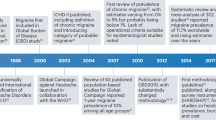Abstract
Migraine is a common episodic disorder with considerable impact on individuals and society. Migraine occurs with the highest prevalence between the ages of 25 and 55 years, potentially the most productive period of life. Severe migraine can lead todisruption of work. family and social life, the long term consequences of which may affect quality of life. The direct costs of migraine (due to medical care) are small compared with the indriect costs caused by absence from work and reduced productivity.
Population-based studies are required to assess incidence. prevalence and distribution of the disease. These studies also reveal that migraine is currently underdiagnosed and undertreated. The cumulative impact of migraine on individuals produces the burden of illness on society. Measuring the severity of migraine is important in understanding the extent of the burden of migraine on the individual and on society. Measures of severity may be useful as predictors of disability and healthcare use. These measures may also be useful in assessing the need for patient care and treatment and help larget those more disabled by migraine. Identifying and treating appropriate patients should reduce the impact of migraine on the individual and the burden of migraine on society.
Similar content being viewed by others
References
Rasmussen BK. Jensen R. Schroll M. et al. Epidemiology of headache in the general population: a prevalence study. J Clin Epidemiol 1991:44: 1147–57
Henry P. Michel P. Bruchet B. et al. A nationwide survey of migraine in Frace: prevalence and clinial features in adults.Cephalalgia 1992; 12: 229–37
Stewart WF. Lipton RB, Celentano DO. et al. Prevalence of migraine headache in the United States. JAMA 1992: 267:64–9
Stewart WF Shechtr A. Rasmussen BK. Migraine prevalence: a review of popuulation-based studies. Neurology 1994: 44Suppl.4: 17–23
Breslau N. Davis GC. Migraine. physical health and psychiatric disorder: a prospective epidemiological study in young adults. J Psychiatr Res 1993: 27: 211–21
Pryse-Phillips W. Findlay H. Tugwell P. et al. A Canadian population survey on the clinical. epidemiologic and societal impact of migraine and tension-type headache. part II. Can J Neurol Sci 1992: 19: 333–9
Lipton RB. Silberstein SO. Stewart WF. An update on the epidemiology of migraine. Headache 1994; 34: 319–28
Stewart WF. Simon D. Shechter A. et al. Population variation in migraine prevalance: a meta-analysis. J Clin Epidemiol.
Stewart WF. Shechter A, Lipton RB. Migraine heterogeneity: disability. pain intensity. and attack frequeney and duration.Neurology 1994; 44 Suppl.6: 24–39
Edmeads J. Findlay H. Tugwell P. et al. Impact of migraine and tension-type headache on lifestyle. consulting behaviour and medication use: a Canadian population survey. Can J Neurol Sci 1993: 20: 131–7
Welch KMA. Migraine and stroke. In Olesen J. Tfelt_Hansen P. Welch MKA. editors. The headaches. Vol.3. New York: Raven Press. 1993: 427–36
Ottman R. Lipton RH. Comorbidity of migraine and epilepsy. Neurology. In press
Stewan WF. Linet MS. Celentano DD. Migraine headaches and panic attacks. Psychosom Med 1989: 51: 559–69
Mecrikangas KR. Angst J. Isler H. Migraine and pschopathology. Results of the Zurich cohort study or young adults. Arch Gen Psychol 1990; 47: 849–53
Breslau N. Migraine. suicidal ideation and suicide attempts. Neurology 1992: 42: 392–5
Merikangas KR. Merikangas JR. Angst J. Headache syndromes and psychiatric disorders: association and familiar transmission. J Psychiatr Res 1993; 27 Suppl.2: 197–210
Lipton RB. Srewart WF. Medical consultation for migraine [abstract]. Neurology 1994; 44 Suppl.2: 199
Osterhaus JT. Gutterman DL. Plachetka JR. Healthcare resourceS and lost labour costs of migraine in the US. Pharamaco Economics 1992: 2: 67–76
Stang PE. Osterhaus JT. Impact of migraine in the United States: data from the National Health interview study. Headache 1993: 33: 29–35
de Lissovoy G. Lazaros SS. The economic cost of migraine: present state of knowledge. Neurology 1994: 44 Suppl.4:56–62
Lipton RB. Amatnick IC. Ferrari MD. et al. Migraine: identifying and removing barriers to care. Neurology 1994: 44Suppl.6: 56–62
Lipton RB. Stewart WF Celentano DD. ee al. Undiagnosed migraine headaches. Arch Intern Med 1992; 152:1273–8
Stang PE. Osterhaus JT. Celentano DD. Migraine: patterns of healthcare use. Neurology 1994: 44 Suppl.6: 47–55
Headache classification committee of the international headache society. Classification and diagnostic criteria for headache disorders,cranial neuralgias and facial pain. Cephalalgia 1988: 8 Suppl.7: 19–28
Lipton RB. Stewart WF Migraine in the United States: a review of epidemiology and healthcare use. Neurology 1993: 43Suppl.3: 6–10
Rasmussen BK. Jensen R. Olesen J. Impact of migraine on sickness. absence and utililization of medical services: a Danish population study. J Epidemiol Community Health 1992;46: 443–6
Lipton RB. Stewart WF. Von Korff M. Individual and Societal impact of migraine. In Olesen J, editor. Headache classification and epidemiology. New York: Raven Press. In press
Celentano DD. Stewart WF. Lipton RB. Medication use and disability among migraineurs. Headache 1992: 32: 223–8
Von Korff M. Ormel J. Keefe F, et al. Grading the severity of chronic pain. Pain 1992: 50: 133–49
Micieli G. Suffering in silence. In: Edmeads J. editor. Migraine: 3 brighter future. Worthing: Cambridge Medical Publications.1991: 1–7
Author information
Authors and Affiliations
Rights and permissions
About this article
Cite this article
Lipton, R.B., Stewart, W.F. & Korff, M.V. The Burden of Migraine. Pharmacoeconomics 6, 215–221 (1994). https://doi.org/10.2165/00019053-199406030-00005
Published:
Issue Date:
DOI: https://doi.org/10.2165/00019053-199406030-00005




